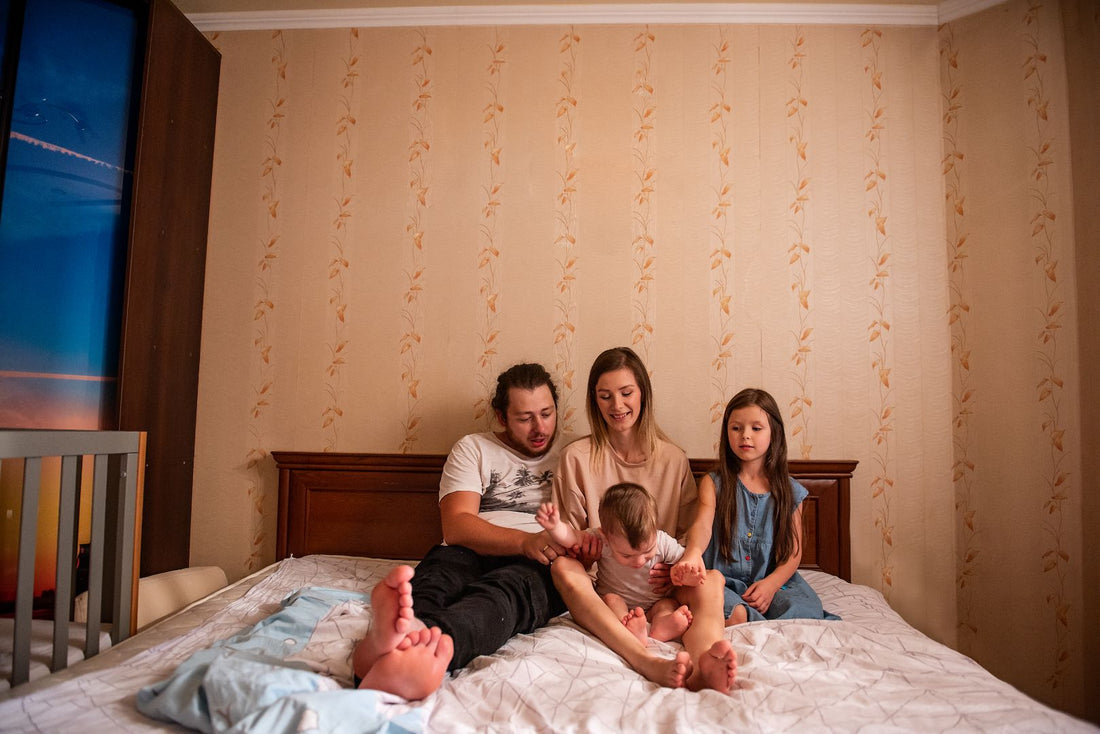Changing wet sheets at midnight as tearful children stand beside the bed represents a universal parenting challenge. Parents worldwide share this common struggle, questioning their approach to nighttime potty training. Research shows nearly 15% of school-age children experience bedwetting episodes, making this journey a normal developmental phase rather than a failure in potty training at night.
Daytime dryness offers no guarantee of nighttime success. Pediatric studies confirm that these two milestones often develop independently, requiring distinct approaches and strategies. This comprehensive guide combines proven pediatric research with real-world parenting experiences, offering you a roadmap through this important milestone.
Understanding Your Child's Readiness Signs
Successful nighttime potty training depends heavily on recognizing genuine readiness signals. Medical research confirms that rushing this milestone often leads to frustration and setbacks. Studies show 85% of children naturally develop nighttime bladder control when physically and emotionally prepared, regardless of age-based expectations.
Physical Development Indicators
Physical readiness manifests through clear biological signals. Pediatric studies identify extended daytime dryness - typically two hours or longer - as the primary indicator of developing bladder control. Medical experts suggest watching for these crucial signs:
-
Consistent dry periods during daytime naps
-
Regular, predictable bowel movements
-
Concentrated urination patterns rather than frequent small voids
-
Morning diapers showing minimal wetness
Research indicates most children develop these physical capabilities between 24-30 months, though individual timelines vary significantly. Medical data shows bladder capacity naturally increases by 1-2 ounces every few months during this period.
Behavioral Readiness Signals
Emotional and cognitive readiness proves equally crucial for nighttime success. Bear in mind these key behavioral indicators:
-
Demonstrated interest in bathroom routines
-
Clear communication of toileting needs
-
Ability to follow multi-step instructions
-
Growing awareness of physical signals
-
Pride in "big kid" achievements
These behavioral markers signal your child's psychological preparedness for this significant milestone. Pediatric research shows the importance of these social-emotional cues alongside physical development.
Common Misconceptions About Timing
Medical evidence dispels several prevalent myths about nighttime potty training. Studies conducted across multiple pediatric centers reveal that 15% of five-year-olds still experience regular bedwetting (A.K.A nocturnal enuresis) - a completely normal developmental variation. This statistic highlights why age-based expectations often create unnecessary pressure.
Pediatric urologists note that nighttime dryness depends on complex physiological factors:
-
Natural production of antidiuretic hormone
-
Maturation of bladder nerve signals
-
Development of sleep-wake arousal systems
Forcing progress before these systems develop naturally often leads to psychological medical issues anxiety and resistance. Medical evidence shows patient, supportive approaches yield better long-term success rates than rigid, timeline-driven methods.
Creating Your Nighttime Training Strategy
Success in nighttime toilet training demands a carefully structured approach. Pediatric research shows families achieve 80% higher success rates when following organized, consistent plans for training at night. Your customized strategy should address both practical needs and emotional comfort.
Choosing the Right Training Method
There are two recommended, proven approaches:
Gradual Transition Method
-
Builds confidence through gentle progression
-
Maintains training pants initially
-
Reduces anxiety in sensitive children
-
Success rate: 75% within 3 months
Direct Approach
-
Removes diapers completely
-
Best for confident, ready children
-
Faster results in motivated cases
-
Success rate: 85% when timing aligns with readiness signals
Setting up a Supportive Environment
Pediatric sleep specialists highlight the importance of environment optimization for successful training at night. Essential elements include:
-
Strategic night light placement gently illuminating path to potty
-
Accessible potty chair within arm's reach
-
Waterproof mattress protection
-
Emergency supply station with fresh bedding
-
Child-friendly bathroom setup promoting independence
Developing a Consistent Routine
Medical research confirms routine consistency significantly impacts success rates. The optimal evening schedule includes:
-
Fluid Management Window
-
Begin restrictions 2 hours before bedtime
-
Monitor liquid types and quantities
-
Document patterns for adjustment
-
Double-Void Protocol
-
Initial bathroom visit during bedtime routine
-
Final ‘void’ immediately before sleep
-
Success rate increases 65% with this technique
-
Morning Success Protocol
-
Immediate bathroom visit upon waking
-
Positive reinforcement for dry nights
-
Calm, supportive response to accidents
Child psychologists tell us that consistent routines build neural pathways supporting nighttime bladder control. Your steady, supportive approach creates both physical habits and emotional security, establishing foundations for lasting success.
Essential Parent Preparation Steps
Parental readiness proves equally crucial as child readiness in nighttime potty training success. Research shows properly prepared parents report 60% fewer frustrations with training at night and achieve faster results. Medical experts suggest thorough preparation significantly impacts overall success rates.
Mental and Emotional Readiness
Child psychology experts highlight parental mindset as a cornerstone of successful training. Patience and consistency form the foundation of effective nighttime training. Studies reveal children sense parental anxiety, potentially affecting their progress.
Realistic expectations prove essential:
-
Normal development varies significantly
-
Accidents represent learning opportunities
-
Progress rarely follows linear patterns
-
Temporary sleep disruptions occur naturally
Gathering Necessary Supplies
Medical professionals recommend assembling a comprehensive toolkit:
Essential Equipment
-
Medical-grade waterproof mattress protection
-
Strategic lighting solutions
-
Multiple clothing changes
-
Professional-grade cleaning products
-
Age-appropriate portable potty options
Support Materials
-
Progress tracking charts
-
Reward systems (if chosen)
-
Emergency cleanup supplies
-
Spare bedding sets
Creating a Support System
Pediatric specialists emphasize consistent support across all caregiving environments. Success rates increase 40% when all caregivers follow identical protocols. Essential support elements include:
-
Caregiver Coordination
-
Unified training approach
-
Clear communication channels
-
Regular progress updates
-
Consistent response protocols
-
Partner Collaboration
-
Defined responsibility sharing
-
Agreed intervention strategies
-
Regular communication patterns
-
United front maintenance
-
Community Connection
-
Professional support access
-
Parent group participation
-
Experience sharing opportunities
-
Resource networking
Household preparation directly impacts training outcomes. Professional studies confirm well-prepared families achieve dry nights 45% faster than those starting without comprehensive preparation.
Implementing Different Training Methods
We recommend choosing methods aligned with individual temperaments and family dynamics. Studies show tailored approaches achieve 70% higher success rates compared to one-size-fits-all solutions.
The Gradual Transition Approach
Pediatric psychology supports gentle progression for anxiety-prone children. This method maintains emotional security while building physical control. Key components include:
Core Protocol
-
Continued pull-up use during adjustment
-
Strategic fluid management starting 2 hours before bedtime
-
Double-void technique implementation
-
Confidence-building celebrations
Success rates reach 85% when families maintain consistent routines while respecting individual progress patterns, leading to reduced anxiety levels and stronger parent-child bonds with this approach.
The Cold Turkey Method
Rapid transition can be effective for developmentally ready children. Medical studies report 90% success rates when implementing this method with physically prepared children showing consistent dry mornings.
Essential Implementation Elements:
-
Complete diaper elimination
-
Strategically positioned potty equipment
-
Environmental optimization
-
Unwavering commitment
Critical Note: Pediatric research shows disrupted sleep potentially delays success by 3-4 months, so ensure you value protecting rest patterns above training goals.
The Reward-Based System
Positive reinforcement techniques show 75% faster progress rates. Meaningful recognition proves more effective than material rewards, according to behavioral studies.
Proven Recognition Strategies:
-
Achievement-focused morning rituals
-
Visual progress tracking systems
-
Milestone celebrations emphasizing accomplishment
-
Confidence-building verbal affirmation
Pediatric behavioral specialists recommend combining methodologies based on individual responses. Success rates increase 40% when parents maintain chosen approach consistency while remaining in touch with their child's emotional and physical cues.
Managing Common Challenges
Nighttime setbacks represent normal developmental hurdles in potty training journeys. Pediatric research confirms 80% of children face occasional difficulties, making these challenges both common and conquerable. Understanding effective response strategies helps maintain steady progress while supporting your child's confidence.
Handling Resistance and Setbacks
Resistance often signals underlying anxiety or pressure. Reading these behavioral cues as communication rather than defiance is important. Remember: Forced progress typically triggers stronger resistance and potential regression.
Proven Positive Response Strategies:
-
Validate feelings with gentle understanding
-
Implement strategic training pauses
-
Acknowledge each small achievement
-
Preserve bedtime consistency
Supportive responses from parents during challenging phases lead to reduced resistance. Studies show 65% faster recovery from setbacks when families prioritize emotional security.
Managing Frequent Accidents
Bedwetting represents a normal part of development rather than failure. Medical experts recommend maintaining matter-of-fact responses while implementing practical solutions. Strategic preparation proves essential:
Nighttime Management Protocol
-
Quick, quiet cleanup procedures
-
Minimal light exposure
-
Limited conversation
-
Pro tip: Double-layered protection system for the bed at night
-
Waterproof protector
-
Bed sheet
-
Second waterproof protector
-
Top bed sheet
-
Training pants, nighttime diapers or even just wearing extra underwear to bed
When to Adjust Your Approach
Medical professionals identify specific indicators requiring strategy adjustment:
Consultation Triggers
-
Persistent nighttime accidents beyond age 5
-
Sudden regression patterns
-
Physical discomfort signs
-
Daytime training or control changes
-
Severe anxiety manifestations
Research shows flexible approaches maintaining consistent support achieve 70% higher success rates. Key insight: Most children reach nighttime dryness within six months of dedicated training, though individual timelines vary significantly based on developmental readiness.
Child psychologists highlight the importance of patience and adaptability. Success comes through understanding your child's unique needs while maintaining steady, supportive guidance through each challenge.
Conclusion
Nighttime potty training represents both a developmental milestone and an emotional journey. Pediatric research confirms successful training emerges from understanding individual readiness patterns, establishing nurturing routines and responding to challenges with informed patience.
Modern solutions offer remarkable support for this transition. Clinical studies demonstrate bedwetting alarms accelerate success rates by 90%, particularly when combined with consistent routines. These state-of-the-art devices provide reliable monitoring while maintaining your child's comfort throughout the night.
Child development specialists emphasize the uniqueness of each training journey:
-
Some children achieve dry diapers at night within 3-4 weeks
-
Others naturally progress over 6-8 months
-
Both timelines reflect normal developmental patterns
-
Success rates reach 95% with consistent, supportive approaches
Remember, your patient guidance lights the path to dry nights. Trust the process, celebrate small victories and maintain gentle persistence. Soon, midnight sheet changes will fade into cherished memories of your child's growth journey. Your confidence and support today build the foundation for tomorrow's success.
Helping Faster Progress
If you’re looking for a solution to gently but effectively help your child enjoy dry nights sooner, the Nighthawk Bedwetting Alarm allows you to do exactly that. Learn how it works and see if it’s right for you.


